Regulidae – Goldcrests & Kinglets
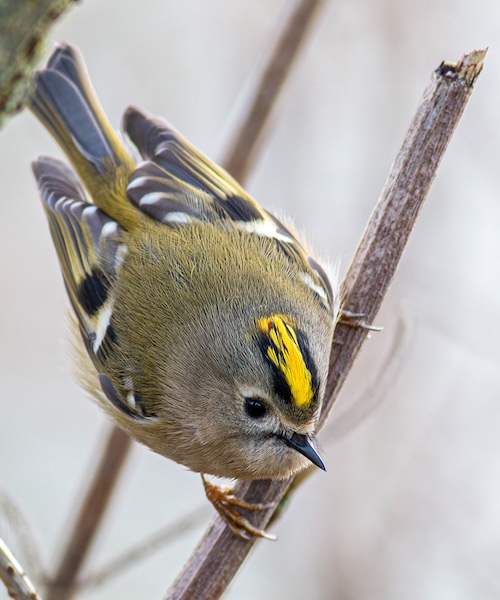
The Regulidae (Kinglets & Crests), are small birds in a passerine group that has sometimes been included in the Old-World warblers, but is more recently firmly placed in its own family. ‘Regulidae‘ is derived from the Latin word regulus for ‘petty king’ or prince, and refers to the coloured crowns of adult birds. This family has representatives in North America and Eurasia. There are just six species in the family; one, the Madeira Firecrest Regulus madeirensis was only recently split from Common Firecrest as a separate species. Moreover, mitochondrial DNA study has established two genera, rather than one genus, with the Ruby-crowned Kinglet being placed in its own genus, Corthylio.
Kinglets are among the smallest of all passerines, ranging in size from 8 to 11 cm and weighing 6 to 8gm; the sexes are the same size. They have medium-length wings and tails, and small needle-like bills. The plumage is overall grey-green, offset by pale wing-bars, and the tail tip is incised. Five species have a single stiff feather covering the nostrils, but in the Ruby-crowned Kinglet, this is replaced by several short, stiff bristles. Most kinglets have distinctive head markings, and the males possess a colourful crown patch. In the females, the crown is duller and yellower. The long feathers forming the central crown stripe can be erected; they are inconspicuous most of the time, but are used in courtship and territorial displays when the raised crest is very striking.
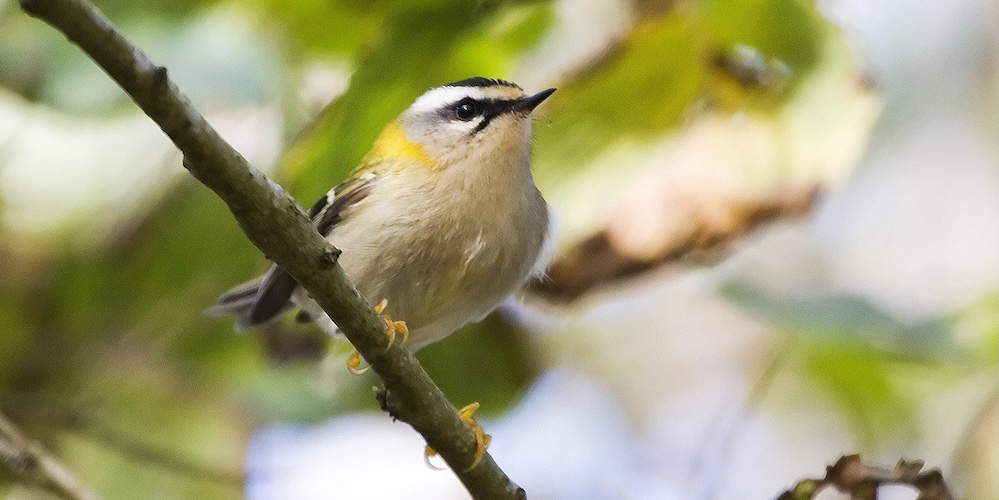
Common Firecrest Regulus ignicapilla – Ashley Beolens
Kinglets are birds of the Nearctic and Palearctic ecozones, with representatives in temperate North America, Europe and Asia, northernmost Africa, Macaronesia and the Himalayas. They are adapted to conifer forests, although there is a certain amount of adaptability and most species will use other habitats, particularly during migration. In Macaronesia, they are adapted to laurisilva and tree heaths.
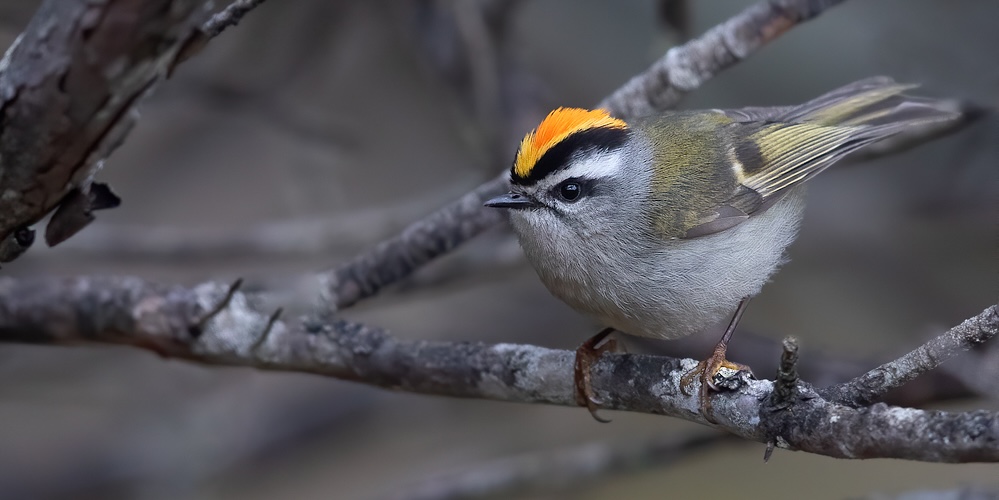
Golden-crowned Kinglet – Regulus satrapa – Dubi Shapiro
There are two species in North America with largely overlapping distributions, and two in Eurasia which also have a considerable shared range. In each continent, one species (Goldcrest in Eurasia and Golden-crowned kinglet in North America) is a conifer specialist; these have deeply grooved pads on their feet for perching on conifer twigs, and a long hind toe and claw for clinging vertically. The two generalists, Ruby-crowned Kinglet and Common Firecrest hunt more in flight, and have smoother soles, shorter hind claws and a longer tail.
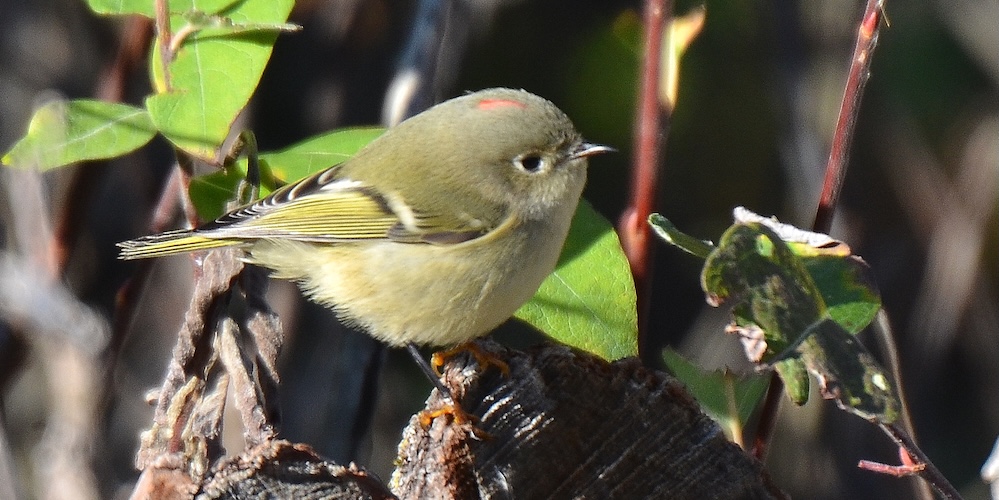
Ruby-crowned Kinglet Corthylio calendula – CheepShot, CC BY 2.0 via Wikimedia Commons
The tiny size and rapid metabolism of kinglets means that they must constantly forage in order to provide their energy needs. They will continue feeding even when nest building. Kinglets prevented from feeding may lose a third of their body weight in twenty minutes and may starve to death in an hour. Kinglets are insectivores, preferentially feeding on insects such as aphids and springtails that have soft cuticles. Prey is generally gleaned from the branches and leaves of trees as the birds move rapidly along a branch and from branch to branch and tree to tree, although in some circumstances prey may be taken on the wing or from the leaf litter on the ground.
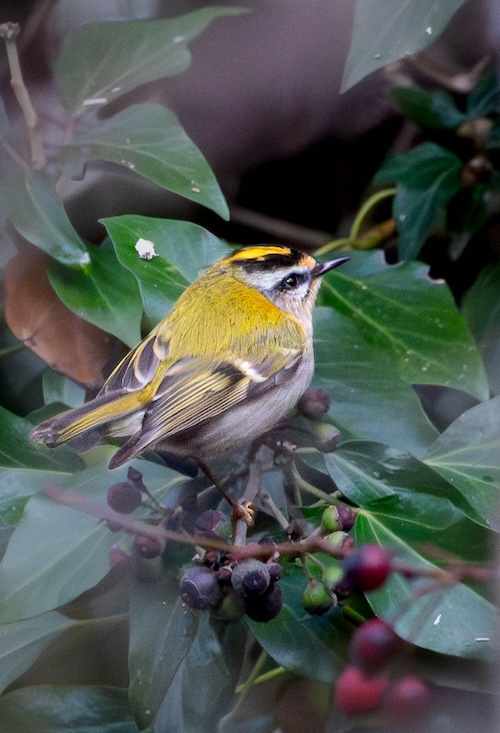
Common Firecrest Regulus ignicapilla – ©Ashley Beolens
The nest are small, very neat cups, almost spherical in shape, made of moss and lichen held together with spiderwebs and hung from twigs near the end of a high branch of a conifer. They are lined with hair and feathers, and a few feathers are placed over the opening. These characteristics provide good insulation against the cold environment. The female lays 7 to 12 eggs, which are white or pale buff, some having fine dark brown spots. Because the nest is small, they are stacked in layers. The female incubates; she pushes her legs (which are well supplied with blood vessels, hence warm) down among the eggs. A unique feature of kinglets is the ‘size hierarchy’ among eggs, with early-laid eggs being smaller than later ones. Eggs hatch asynchronously after 15 to 17 days. The young stay in the nest for 19 to 24 days. After being fed, nestlings make their way down to the bottom of the nest, pushing their still-hungry siblings up to be fed in their turn (but also to brave the cold).
Kinglets are the most fecund and shortest-living of all altricial birds, and probably the shortest-lived apart from a few smaller galliform species. Adult mortality for the Goldcrest is estimated at over 80 percent per year and the maximum lifespan is only six years.
-
Number of bird species: 6
(As at October 2025)
According to the recently (2025) amalgamated AviList, there are just six species, in two genera in the Regulidae family. They are:
Ruby-crowned Kinglet Corthylio calendula
Madeira Firecrest Regulus madeirensis
Common Firecrest Regulus ignicapilla
Golden-crowned Kinglet Regulus satrapa
Flamecrest Regulus goodfellowi
Goldcrest Regulus regulus
-
Regulidae
Family AccountThe kinglets are tiny, energetic songbirds of northern temperate treetops. They glean insects from bark crevices, twigs, and leaf clusters, often hovering... -
Regulidae
Family AccountA kinglet is a small bird in the family Regulidae. Species in this family were formerly classified with the Old World warblers.
-
Firecrest Regulus ignicapillus
Species AccountThe common firecrest (Regulus ignicapilla) also known as the firecrest, is a very small passerine bird in the kinglet family. -
Firecrest Regulus ignicapillus
Species AccountSound archive and distribution map. -
Flamecrest Regulus goodfellowi
Species AccountThe flamecrest or Taiwan firecrest (Regulus goodfellowi) is a species of bird in the kinglet family, Regulidae, that is endemic to the mountains of the island of Taiwan. -
Flamecrest Regulus goodfellowi
Species AccountThe global population size has not been quantified, but the species is described as common (del Hoyo et al. 2006), while the population in Taiwan has been estimated at c.10,000-100,000 breeding pairs (Brazil 2009). -
Flamecrest Regulus goodfellowi
Species AccountSound archive and distribution map. -
Goldcrest Regulus regulus
Species AccountTiny bird, smaller than warblers, with a distinctive combination of black-edged golden crown stripe, big dark eye giving impression of innocent face. -
Goldcrest Regulus regulus
Species AccountThe goldcrest (Regulus regulus) is a very small passerine bird in the kinglet family. Its colourful golden crest feathers gives rise to its English and scientific names, and possibly to it being called the "king of the birds" in European folklore. -
Goldcrest Regulus regulus
Species AccountSound archive and distribution map. -
Golden-crowned Kinglet Regulus satrapa
Species AccountSound archive and distribution map. -
Golden-crowned Kinglet Regulus satrapa
Species AccountThe golden-crowned kinglet (Regulus satrapa) is a very small songbird. -
Golden-crowned Kinglet Regulus satrapa
Species AccountThis species has an extremely large range, and hence does not approach the thresholds for Vulnerable under the range size criterion. -
Golden-crowned Kinglet Regulus satrapa
Species AccountTiny, hyperactive songbird usually found in conifer trees. Look for black stripes on the head and bold wing pattern. -
Madeira Firecrest Regulus madeirensis
Species AccountAn endemic species of Madeira easily identified by its orange crown stripe. It has a dark face with a white supercilium stripe that does not extend beyond the eye and a white contour line below the eye. -
Madeira Firecrest Regulus madeirensis
Species AccountThe Madeira firecrest, Madeira kinglet, or Madeiracrest (Regulus madeirensis) is a very small passerine bird endemic to the island of Madeira. -
Madeira Firecrest Regulus madeirensis
Species AccountSound archive and distribution map. -
Ruby-crowned Kinglet Regulus calendula
Species AccountTiny, hyperactive songbird with an uneven white eyering. Plain olive overall, with slightly brighter greenish edges on the wing and tail feathers. -
Ruby-crowned Kinglet Regulus calendula
Species AccountThe ruby-crowned kinglet (Regulus calendula) is a very small passerine bird found throughout North America. -
Ruby-crowned Kinglet Regulus calendula
Species AccountSound archive and distribution map
